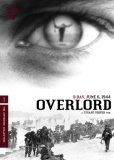| Reviews & Columns |
|
Reviews DVD TV on DVD Blu-ray 4K UHD International DVDs In Theaters Reviews by Studio Video Games Features Collector Series DVDs Easter Egg Database Interviews DVD Talk Radio Feature Articles Columns Anime Talk DVD Savant Horror DVDs The M.O.D. Squad Art House HD Talk Silent DVD
|
DVD Talk Forum |
|
|
| Resources |
|
DVD Price Search Customer Service #'s RCE Info Links |
|
Columns
|
|
|
Overlord - Criterion Collection
THE MOVIE:
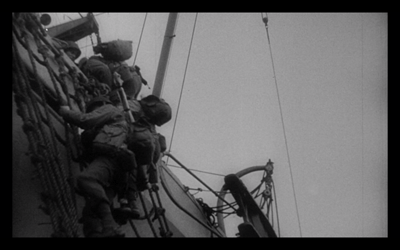
Ever since I saw the clips from Overlord in Alexandra Cassavetes' documentary Z Channel: A Magnificent Obsession, it's been high on my list of films to see if ever I could lay my hands on it. This was no easy task, however. Outside of its airing on that legendary cable channel and a few special screenings, it's never really been available in the United States. So, I played that game we all play in the DVD age: I added it to my wish list and hoped that somewhere a cinema genie would pick up on my desire and grant it.
In the case of Overlord, it's the folks at Criterion who granted me my wish. Working with director Stuart Cooper, they have brought the 1975 World War II picture to DVD, meticulously creating a new high-definition transfer so that those of us seeing this unique film for the first time can see it as it was intended.
Overlord is the story of Private Tom Beddows (Brian Stirner), a sheltered English teen whose life is forever changed the day he leaves for the army--as it was for some many young men during the war. Though there is no way that Tom can know that he will be one of the first on the beach on D-Day (much less know what D-Day is), a sense of doom hangs over him. All through basic training and up to his first assignment out of country, he knows that something is going to happen to him, that's he's going to die. He just doesn't know how.
Actually, he doesn't even know what for most of the movie, at least not enough to say it out loud, not until he's much closer. Instead, he wanders blankly through his service, not really acting unless ordered to by officers or coerced by friends. Only when he meets a girl (Julie Neesam) does he make a decision for himself. He promises to see her again, but as such things go, of course, he never will.
Cooper shows Tom's anxieties through a series of montages, splicing together archival footage with more surreal takes on the average battle scene. That's actually what sets Overlord apart from most other WWII pictures, its extensive use of actual wartime film elements taken from Britain's Imperial War Museum. Working with cinematographer John Alcott (a Kubrick collaborator) and editor Jonathan Gili, Cooper patches the new and the old together in such a way that you can't really tell the difference. By using a black-and-white film stock with a slight grain, they remove any demarcation from past and present, fiction and non-fiction. It's all part of Tom's interior odyssey.
We know that the scenes we see are not ones Tom will be a part of because, in addition to the dream-like touches, some of the battle sequences are ones he couldn't possibly be privy to. For instance, how would he witness a dogfight from inside a cockpit? He's not a pilot. In some cases, we actually see Tom wake from his dreams. The most extensive visions come to him when he's in transit, either riding on a train or a transport jeep. This lends to the feeling that Tom is heading for something. The army has placed him on a slow-boat toward destiny. Any time he is not in motion, he is just biding time.
Once D-Day finally arrives--and Tom arrives at his destination (I never noticed the root of that word before)--it's not a gung-ho rush onto the French shores. It's a quiet event for the soldiers on the troop boats. It's here that we realize that for Tom and his buddies, preparing for battle wasn't a process of building oneself up; rather, it was a process of emptying oneself out. Symbolically, this shows up in Tom's dreams as a scene where the girl he is sweet on strips him down and uses him as a model to demonstrate how to prepare the fallen for burial. In his real-life exploits, we can see the change in the move from a crowded movie theatre to an empty music hall where Tom and another soldier are the only witnesses to a sad performance. A mother forces her daughter to sing a song about love that she's way too young to understand, and the young girl performs with great reluctance. Her fumbling isolation on the stage is no different than Tom's sleepwalking through his service. The saddest thing--or perhaps, for them, a stroke of great luck--is that there is no one to bear witness to their struggle. Even the army accepts that there is nothing left of the boy (boys) who first joined them, instructing the soldiers to throw all of their personal papers on a bonfire before heading into battle.
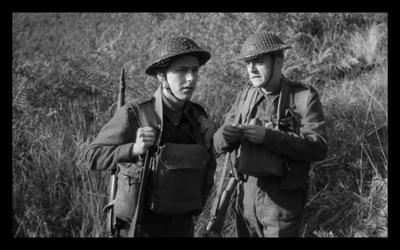
Made during the end stages of the Vietnam War, it's no wonder a thoughtful filmmaker like Cooper would make a brooding film about the effects of war on a young person's mind. Born in New Jersey in 1942, the threat of the draft must have dogged the director through his twenties. Overlord takes great pains not to give the fighting a mythic quality. Really, the archival footage is the best tool for that. The camera could only ever get so close to the skirmish, and Cooper never takes us into the thick of it nor creates any action scenes out of whole cloth (Overlord stops just short of the big conflict). For him, the sacrifice soldiers make is more anonymous. Tom's fate could be the same as the many others in the great waves of boys sent to the frontlines. It doesn't make Tom's willingness to go any less noble. Really, in an existential sense, it's more noble choosing to act even when you know it's futile. To my mind, Cooper is saying far be it from any of us to glorify what happened after the fact, the glory is for the men who were there. Hence, the only warfare he'd commit to celluloid was that which really happened. There is no faking it.
So, be warned, those going into Overlord looking for explosions and rifle fire, this isn't your average D-Day movie. You're probably going to find it a little slow. To be honest, even going in expecting something different, you might find it a little slow, too. But that's just the dream-like state Stuart Cooper is going for, like the image of the runner that keeps recurring, never coming into focus, never seeming to get where he's going. In a way, we have to be like the dreamer, be like Tom, and instead of struggling against it, we have to accept that it only gets easier the more we surrender. When you do, that's when Overlord will crack open for you, revealing its inner secrets, and in a flash, a single gun blast, it will all make sense.
THE DVD
Video:
Stuart Cooper oversaw the digital transfer of Overlord, and it must have been a delicate process to get the image right. The interweaving of the real and the fictional, footage shot thirty years apart, could have been jarring, but Cooper manages to make it all look like it's coming from the same source. The final product is immaculate.
The movie's aspect ratio is 1.66:1.
Sound:
The only available audio mix is mono, but it manages to have some nice qualities despite the lo-fi presentation. The sound levels are well done, achieving a nice clarity for the dialogue and capturing the deep tones of Paul Glass' musical score.
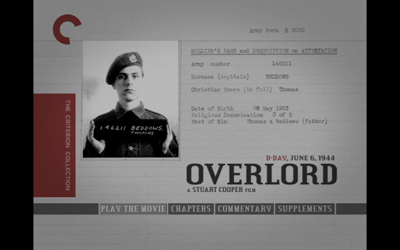
Extras:
For the bonus section, Criterion has done it up right for Overlord, rolling out a bevy of supplemental features to enhance your viewing of the movie.
Top of the list for those interested in the historical aspect of this war picture is Mining the Archive (23 minutes, 20 seconds), featuring two archivists from the Imperial War Museum. They explain the mechanics of the initiative to chronicle the war and honor the camermen who shot the footage that Cooper used. They then go into further detail about where some of the material came from, and also show a little bit of the D-Day footage filmed after the troops made it up the beach. More D-Day images and the experience of a war photographer are the focus of Capa Influences Cooper (8:00), a collection of Robert Capa's still photos from Normandy. Cooper talks over the photographs, explaining how these and Capa's Spanish Civil War collection (some also shown) were an influence on both Overlord and his short film from 1969, A Test of Violence (14:20) . To illustrate this, Violence is included. It's an abstract piece about the Spanish artist Juan Genovés, using animation and film trickery to showcase his paintings. Further tribute is paid to battle correspondents in the 1943 newsreel Camermen at War (14:30). Another propaganda film, German Calling (2:00) takes a more humorous approach to disinformation. It's the 1941 film that Tom watches in the movie theatre in Overlord, where images of the Nazis have been edited so it appears they are dancing.
The Imperial War Museum, in addition to the extensive journalistic material about WWII, keeps a collection of correspondence by the soldiers, including letters and diaries. Stuart Cooper and his co-writer Christopher Hudson studied these to find new experiences to draw from for Tom's personal journey in Overlord. Three audio files give us a glimpse of these diaries: a short introduction from Cooper and then two readings from the real text by actor Brian Stirner. The soldiers write in a stark manner that is startling in its poetry.
Stuart Cooper and Stirner recorded a feature-length audio commentary to go with Overlord (though they did so separately). Cooper is as meticulous in explaining how the movie was put together as he was in assembling it. Stirner comes from the vantage point of it having been his first movie, and one where half of what is on the screen was put together in post-production, long before digital effects made that more commonplace. What's really nice about the commentary is that it's not mostly repeated information from the other supplements. There's so much to talk about, neither commentator runs out of fresh material.
The last of the features are the original theatrical trailer and a 28-page booklet with an essay by Film Comment's Kent Jones, more on the Imperial War Museum, and an excerpt from the Overlord novelization by Cooper and Hudson.
On a side note, what's going on with the Criterion art direction lately? While all the boxes look great, just about all of the releases from the last couple of months have a black-and-white design palette. There's a huge gray chunk at the end of my Criterion shelf. Where did all the color go?
FINAL THOUGHTS:
Overlord – Criterion Collection is a fascinating film, an historical curiosity of indie cinema that's been rescued from obscurity by DVD. Stuart Cooper recreates one soldier's inner struggle by melding archival footage from WWII with a fictional narrative, creating a kind of cinematic alchemy that brings a freshness to the D-Day story. Criterion has rewarded this effort with a package that reaches the high water mark for DVDs, coupling a clean transfer with truly excellent bonus features. While I did find Overlord a little slow, the presentation itself elevates the standard, and so, the Overlord – Criterion Collection disc is Highly Recommended.
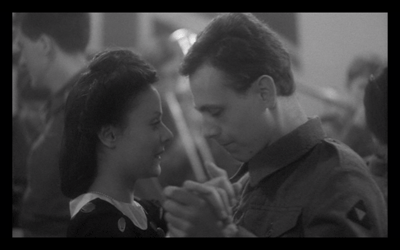
Jamie S. Rich is a novelist and comic book writer. He is best known for his collaborations with Joelle Jones, including the hardboiled crime comic book You Have Killed Me, the challenging romance 12 Reasons Why I Love Her, and the 2007 prose novel Have You Seen the Horizon Lately?, for which Jones did the cover. All three were published by Oni Press. His most recent projects include the futuristic romance A Boy and a Girl with Natalie Nourigat; Archer Coe and the Thousand Natural Shocks, a loopy crime tale drawn by Dan Christensen; and the horror miniseries Madame Frankenstein, a collaboration with Megan Levens. Follow Rich's blog at Confessions123.com.
|
| Popular Reviews |
| Sponsored Links |
|
|
| Sponsored Links |
|
|
| Release List | Reviews | Shop | Newsletter | Forum | DVD Giveaways | Blu-Ray | Advertise |
|
Copyright 2024 DVDTalk.com All Rights Reserved. Legal Info, Privacy Policy, Terms of Use,
Manage Preferences,
Your Privacy Choices | |||||||









